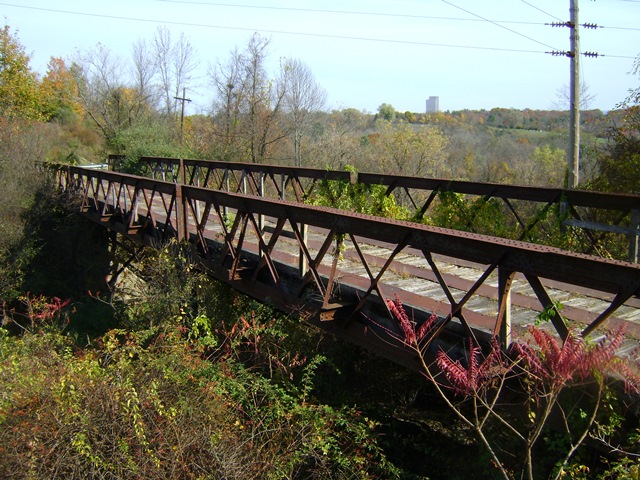We Recommend:
Bach Steel - Experts at historic truss bridge restoration.
Rockefeller Road Bridge

Primary Photographer(s): Marc Scotti
Bridge Documented: October 21, 2013
Rural: Albany County, New York: United States
By Builder/Contractor: Unknown
Not Available or Not Applicable
50.0 Feet (15.2 Meters)
157.0 Feet (47.9 Meters)
17 Feet (5.18 Meters)
3 Main Span(s)
2200190

View Information About HSR Ratings
Bridge Documentation
This bridge no longer exists!
Bridge Status: This historic bridge was demolished for absolutely no reason whatsoever in 2015!This unique Double-Warren pony truss bridge crosses the original Delaware and Hudson main line, which was re-routed a long time ago. The truss configuration and the heavy use of angles and plates with no lacing or lattice indicates this was a railroad-designed bridge. Such bridges also have a history of relocation so it is not known if this is the original location of the trusses. The 1914 construction date given by the National Bridge Inventory certainly suggests relocation as it is assumed the truss spans are older based on design. Similar bridges that are more massive in construction have been dated to ca. 1890 or earlier. There is no reason to believe this bridge is not at least that old as well. The SHPO database had a ca. 1906 date listed. The accuracy of either date is unknown.
This example stands out from similar examples nationwide due to its multi-span configuration and use of riveted steel bents.
The bridge was abandoned, but not in the way of anything, and it would have been a major, highly significant historic landmark along the rail-trail so whoever thought it was a good idea to demolish this bridge was clearly devoid of any common sense, decency, or respect for the use of taxpayer dollars. The loss of a highly significant truss like this for no reason is absolutely ridiculous and shameful. This is not even the worst of it however!!! The SHPO (that would be the State HISTORIC PRESERVATION Office) listed this bridge as INELIGIBLE for listing in the National Register of Historic Places "because it lacks distinguishing characteristics and is in poor condition." This shows a complete lack of understanding of what makes a bridge eligible for the National Register. Is there not a single bridge historian working for the SHPO?! No distinguishing features?! What do they think a rare railroad-designed steel angle-plate-based truss bridge that MIGHT date to 1906 but could very well be older (no source for that date was cited) is?! Also, because a truss bridge is in poor condition is absolutely no excuse for an ineligible finding if that were the case nearly every historic metal bridge in the United States would be found inelgible including nationally significant bridges like the Brooklyn Bridge which prior to rehab was in very poor condition. The National Register is not a bridge inspection rating system. It is not based off how deteriorated a bridge is. As long as the deterioration has not resulted in actual character-defining bridge parts missing or becoming beyond in-kind repair/replacement in keeping with the Secretary of Interior Standards for Rehabilitation (which this bridge had NOT deteriorated even close to that point) then the bridge should be found eligible. As if to rub salt in the wound, the SHPO also found a nearby tiny culvert-sized cattle pass, merely a slab of rotting wood (in other words in POOR CONDITION) on stone abutments built ca. 1890 as ELIGIBLE. While HistoricBridges.org does not dispute that finding, this lack of consistency makes no sense whatsoever. Perhaps an unpaid intern did this report?
View Archived National Bridge Inventory Report - Has Additional Details and Evaluation
View Historic Bridge Inventory Sheet For This Bridge
This bridge is tagged with the following special condition(s): Unorganized Photos
![]()
Photo Galleries and Videos: Rockefeller Road Bridge
Unorganized Photos
Original / Full Size PhotosA collection of overview and detail photos, presented as an unorganized and unlabeled collage and gallery. This gallery offers photos in the highest available resolution and file size in a touch-friendly popup viewer.
Alternatively, Browse Without Using Viewer
![]()
Unorganized Photos
Mobile Optimized PhotosA collection of overview and detail photos, presented as an unorganized and unlabeled collage and gallery. This gallery features data-friendly, fast-loading photos in a touch-friendly popup viewer.
Alternatively, Browse Without Using Viewer
![]()
Maps and Links: Rockefeller Road Bridge
This historic bridge has been demolished. This map is shown for reference purposes only.
Coordinates (Latitude, Longitude):
Search For Additional Bridge Listings:
Bridgehunter.com: View listed bridges within 0.5 miles (0.8 kilometers) of this bridge.
Bridgehunter.com: View listed bridges within 10 miles (16 kilometers) of this bridge.
Additional Maps:
Google Streetview (If Available)
GeoHack (Additional Links and Coordinates)
Apple Maps (Via DuckDuckGo Search)
Apple Maps (Apple devices only)
Android: Open Location In Your Map or GPS App
Flickr Gallery (Find Nearby Photos)
Wikimedia Commons (Find Nearby Photos)
Directions Via Sygic For Android
Directions Via Sygic For iOS and Android Dolphin Browser
USGS National Map (United States Only)
Historical USGS Topo Maps (United States Only)
Historic Aerials (United States Only)
CalTopo Maps (United States Only)

